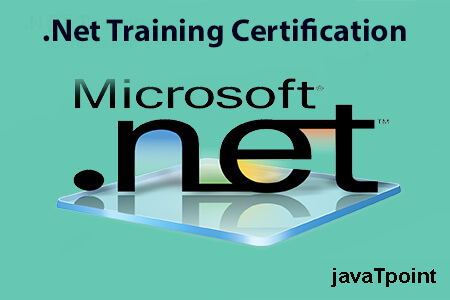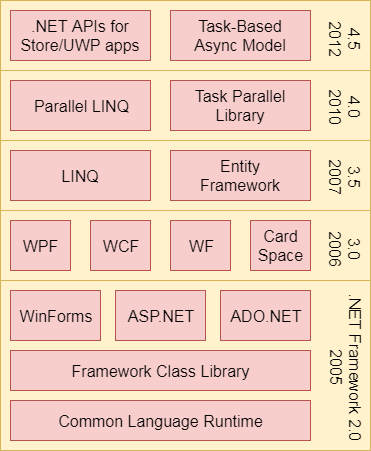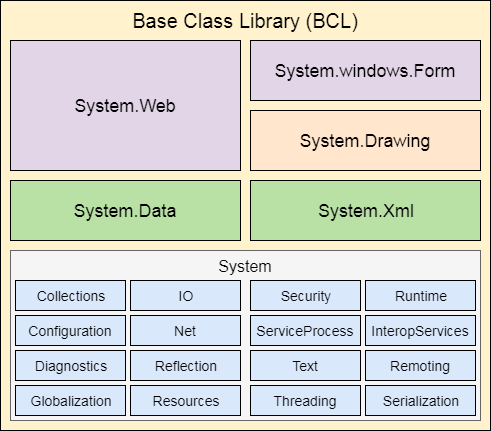.NET Framework
.NET is a framework to develop software applications. It is designed and developed by Microsoft and the first beta version released in 2000. It is used to develop applications for web, Windows, phone. Moreover, it provides a broad range of functionalities and support. This framework contains a large number of class libraries known as Framework Class Library (FCL). The software programs written in .NET are executed in the execution environment, which is called CLR (Common Language Runtime). These are the core and essential parts of the .NET framework. This framework provides various services like memory management, networking, security, memory management, and type-safety. The .Net Framework supports more than 60 programming languages such as C#, F#, VB.NET, J#, VC++, JScript.NET, APL, COBOL, Perl, Oberon, ML, Pascal, Eiffel, Smalltalk, Python, Cobra, ADA, etc. Following is the .NET framework Stack that shows the modules and components of the Framework. The .NET Framework is composed of four main components:

CLR (Common Language Runtime)It is a program execution engine that loads and executes the program. It converts the program into native code. It acts as an interface between the framework and operating system. It does exception handling, memory management, and garbage collection. Moreover, it provides security, type-safety, interoperability, and portablility. A list of CLR components are given below: 
FCL (Framework Class Library)It is a standard library that is a collection of thousands of classes and used to build an application. The BCL (Base Class Library) is the core of the FCL and provides basic functionalities. 
WinFormsWindows Forms is a smart client technology for the .NET Framework, a set of managed libraries that simplify common application tasks such as reading and writing to the file system. ASP.NETASP.NET is a web framework designed and developed by Microsoft. It is used to develop websites, web applications, and web services. It provides a fantastic integration of HTML, CSS, and JavaScript. It was first released in January 2002. ADO.NETADO.NET is a module of .Net Framework, which is used to establish a connection between application and data sources. Data sources can be such as SQL Server and XML. ADO .NET consists of classes that can be used to connect, retrieve, insert, and delete data. WPF (Windows Presentation Foundation)Windows Presentation Foundation (WPF) is a graphical subsystem by Microsoft for rendering user interfaces in Windows-based applications. WPF, previously known as "Avalon", was initially released as part of .NET Framework 3.0 in 2006. WPF uses DirectX. WCF (Windows Communication Foundation)It is a framework for building service-oriented applications. Using WCF, you can send data as asynchronous messages from one service endpoint to another. WF (Workflow Foundation)Windows Workflow Foundation (WF) is a Microsoft technology that provides an API, an in-process workflow engine, and a rehostable designer to implement long-running processes as workflows within .NET applications. LINQ (Language Integrated Query)It is a query language, introduced in .NET 3.5 framework. It is used to make the query for data sources with C# or Visual Basics programming languages. Entity FrameworkIt is an ORM based open source framework which is used to work with a database using .NET objects. It eliminates a lot of developers effort to handle the database. It is Microsoft's recommended technology to deal with the database. Parallel LINQParallel LINQ or PLINQ is a parallel implementation of LINQ to objects. It combines the simplicity and readability of LINQ and provides the power of parallel programming. It can improve and provide fast speed to execute the LINQ query by using all available computer capabilities. Apart from the above features and libraries, .NET includes other APIs and Model to improve and enhance the .NET framework. In 2015, Task parallel and Task parallel libraries were added. In .NET 4.5, a task-based asynchronous model was added. .NET Framework Index.Net Framework C#
C# Control Statements
C# Functions C# Arrays
C# Objects and Classes
C# Properties C# Inheritance C# Polymorphism C# Abstraction C# Namespace C# Strings C# String Functions
C# Exceptions
C# File I/O
C# Collections
C# Generics C# Delegates C# Reflection C# Anonymous Functions C# Multithreading
C# Synchronization C# New Features C# 2.0
C# 3.0
C# 4.0
C# 5.0 C# 6.0
C# 7.0 C# 7.1 C# Programs List
C# Interview Questions ADO.NET Tutorial
ADO.NET Interview Questions ASP.NET Tutorial ASP.NET Web Forms
ASP.NET Validation ASP.NET MVC
ASP.NET Razor
ASP.NET Interview Questions
Next Topic.NET Common Language Runtime
|
 For Videos Join Our Youtube Channel: Join Now
For Videos Join Our Youtube Channel: Join Now
Feedback
- Send your Feedback to [email protected]
Help Others, Please Share










